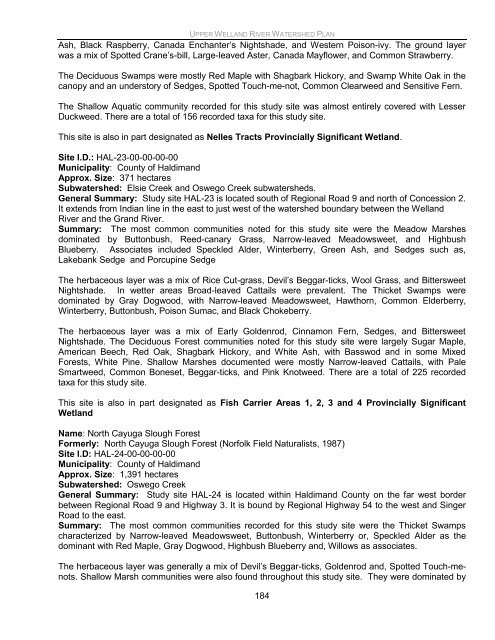Upper Welland River Watershed Plan - Niagara Peninsula ...
Upper Welland River Watershed Plan - Niagara Peninsula ...
Upper Welland River Watershed Plan - Niagara Peninsula ...
You also want an ePaper? Increase the reach of your titles
YUMPU automatically turns print PDFs into web optimized ePapers that Google loves.
UPPER WELLAND RIVER WATERSHED PLANAsh, Black Raspberry, Canada Enchanter‟s Nightshade, and Western Poison-ivy. The ground layerwas a mix of Spotted Crane‟s-bill, Large-leaved Aster, Canada Mayflower, and Common Strawberry.The Deciduous Swamps were mostly Red Maple with Shagbark Hickory, and Swamp White Oak in thecanopy and an understory of Sedges, Spotted Touch-me-not, Common Clearweed and Sensitive Fern.The Shallow Aquatic community recorded for this study site was almost entirely covered with LesserDuckweed. There are a total of 156 recorded taxa for this study site.This site is also in part designated as Nelles Tracts Provincially Significant Wetland.Site I.D.: HAL-23-00-00-00-00Municipality: County of HaldimandApprox. Size: 371 hectaresSubwatershed: Elsie Creek and Oswego Creek subwatersheds.General Summary: Study site HAL-23 is located south of Regional Road 9 and north of Concession 2.It extends from Indian line in the east to just west of the watershed boundary between the <strong>Welland</strong><strong>River</strong> and the Grand <strong>River</strong>.Summary: The most common communities noted for this study site were the Meadow Marshesdominated by Buttonbush, Reed-canary Grass, Narrow-leaved Meadowsweet, and HighbushBlueberry. Associates included Speckled Alder, Winterberry, Green Ash, and Sedges such as,Lakebank Sedge and Porcupine SedgeThe herbaceous layer was a mix of Rice Cut-grass, Devil‟s Beggar-ticks, Wool Grass, and BittersweetNightshade. In wetter areas Broad-leaved Cattails were prevalent. The Thicket Swamps weredominated by Gray Dogwood, with Narrow-leaved Meadowsweet, Hawthorn, Common Elderberry,Winterberry, Buttonbush, Poison Sumac, and Black Chokeberry.The herbaceous layer was a mix of Early Goldenrod, Cinnamon Fern, Sedges, and BittersweetNightshade. The Deciduous Forest communities noted for this study site were largely Sugar Maple,American Beech, Red Oak, Shagbark Hickory, and White Ash, with Basswod and in some MixedForests, White Pine. Shallow Marshes documented were mostly Narrow-leaved Cattails, with PaleSmartweed, Common Boneset, Beggar-ticks, and Pink Knotweed. There are a total of 225 recordedtaxa for this study site.This site is also in part designated as Fish Carrier Areas 1, 2, 3 and 4 Provincially SignificantWetlandName: North Cayuga Slough ForestFormerly: North Cayuga Slough Forest (Norfolk Field Naturalists, 1987)Site I.D: HAL-24-00-00-00-00Municipality: County of HaldimandApprox. Size: 1,391 hectaresSubwatershed: Oswego CreekGeneral Summary: Study site HAL-24 is located within Haldimand County on the far west borderbetween Regional Road 9 and Highway 3. It is bound by Regional Highway 54 to the west and SingerRoad to the east.Summary: The most common communities recorded for this study site were the Thicket Swampscharacterized by Narrow-leaved Meadowsweet, Buttonbush, Winterberry or, Speckled Alder as thedominant with Red Maple, Gray Dogwood, Highbush Blueberry and, Willows as associates.The herbaceous layer was generally a mix of Devil‟s Beggar-ticks, Goldenrod and, Spotted Touch-menots.Shallow Marsh communities were also found throughout this study site. They were dominated by184
















